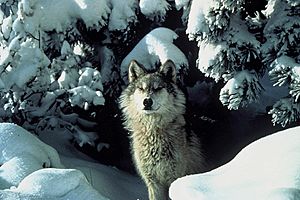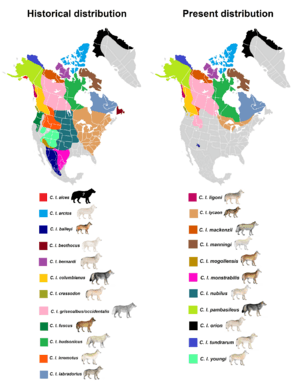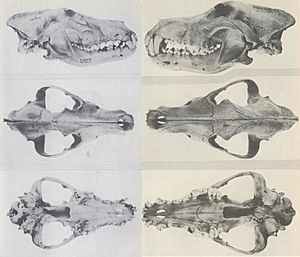Northern Rocky Mountain wolf facts for kids
Quick facts for kids Northern Rocky Mountain wolf |
|
|---|---|
 |
|
| Scientific classification |
|
| Kingdom: | Animalia |
| Phylum: | Chordata |
| Class: | Mammalia |
| Order: | Carnivora |
| Family: | Canidae |
| Genus: | Canis |
| Species: | |
| Subspecies: |
C. l. irremotus
|
| Trinomial name | |
| Canis lupus irremotus Goldman, 1937
|
|
 |
|
| Historical and present range of gray wolf subspecies in North America | |
The northern Rocky Mountain wolf (Canis lupus irremotus) is a type of gray wolf that lives in the northern Rocky Mountains. These wolves are usually light-colored and medium to large in size. They have a flat bone at the front of their head.
This wolf was first listed as an endangered species in 1978. But, its protection was removed in 2000. This happened because of a plan called the Northern Rocky Mountain Wolf Recovery Plan. Later, in 2010, a judge ordered the wolf to be protected again. This decision was changed in 2012. The wolf was taken off the endangered list because Idaho, Montana, and Wyoming had enough wolves. Scientists recognize this wolf as a subspecies of Canis lupus.
Contents
Physical Description
Size and Appearance
The northern Rocky Mountain wolf is one of the largest types of gray wolves. It usually weighs between 70 and 150 pounds (32–68 kg). It stands about 26–32 inches (66–81 cm) tall.
These wolves are lighter in color. Their fur often has more white and less black. They mostly live in western Montana, eastern Idaho, western Wyoming, and southern Alberta.
Dietary Habits
Northern Rocky Mountain wolves mainly hunt large animals. Their favorite foods include bison, elk, and mule deer. They also eat beavers.
These wolves are opportunistic. This means they will eat other animals if they get the chance. Small prey animals are not a big part of their diet.
When a wolf or a pack catches a lot of prey, they eat a lot. A wolf might eat 10–21% of its body weight in a day. Some have even eaten up to 37% of their body weight. But, when food is scarce, they can survive on very little. If there is a severe food shortage, a pack might kill and eat an injured or weak member.
History and Protection
Early History
In the past, northern Rocky Mountain wolves lived mostly in the forests. These forests later became Yellowstone National Park. They lived near Native American tribes like the Tukudika. These tribes thought the wolf was a sacred animal.
Conflict with Settlers
In the late 1800s, more people moved west in America. Ranchers, farmers, and cattle drivers settled in the wolf's territory. The wolves started hunting the settlers' livestock.
In 1915, people began trying to get rid of the wolves. They used guns, traps, and poison. This effort grew stronger in 1916. The National Park Service was created. It allowed killing animals that were "detrimental" to the land. By 1924, the last known wolves in Yellowstone were killed. A few wolves survived in areas outside the park.
Northern Rocky Mountain Wolf Recovery Plan
The Northern Rocky Mountain Wolf Recovery Plan started in 1980 and was updated in 1987. The plan aimed to bring wolves back to the Yellowstone area. It required at least ten breeding pairs of wolves. The population needed to stay stable for three years in a row.
At first, the northern Rocky Mountain wolf was not officially recognized as a subspecies. So, the plan used Mackenzie Valley wolves instead. These wolves lived in similar areas and were more common. This helped avoid upsetting wolf populations elsewhere.
People worried that wolves would kill livestock without consequences. So, the final plan in 1994 added a rule. Ranchers could kill wolves if they were caught attacking livestock on private land.
Some groups went to court over the reintroduction. They worried the new wolves would harm existing ones. Others wanted the wolves to have full protection. A judge first ruled against the reintroduction. But, a higher court later overturned this decision.
Changes in Wolf Protection Laws
In 2007, a new idea about the Endangered Species Act (ESA) came up. It changed how the law looked at a species' "significant portion of its range." This idea said that only the current range mattered, not the historical one. Many environmental groups were upset. They feared this could lead to many species being taken off the endangered list. This might happen even if their populations were still very low.
One ruling based on this idea affected the northern Rocky Mountain wolf. It limited the protection for the species. However, in 2009, wildlife groups challenged this ruling.
In 2010, a judge named Donald Molloy made an important ruling. He said the northern Rocky Mountain wolf must either be fully protected or not protected at all. Its protection could not be different in each state. The U.S. Fish and Wildlife Service said that wolves would stay protected until Wyoming met its population goals. Idaho and Montana had already met their goals.
On August 31, 2012, the US Fish and Wildlife Service announced a big change. They removed endangered species protection for the northern Rocky Mountain wolf. This happened because Wyoming had reached its goal of 328 wolves. The director of the Fish and Wildlife Service called it a "major success story." Wyoming also created its own system. It protects wolves inside Yellowstone Park. But, wolves that leave the park can be hunted. Out of 328 wolves in Wyoming, 224 live outside Yellowstone Park.
In 2014, a court changed this again. The northern Rocky Mountain wolf went back to being a protected population in Wyoming.
See also
 In Spanish: Lobo del norte de las Montañas Rocosas para niños
In Spanish: Lobo del norte de las Montañas Rocosas para niños


